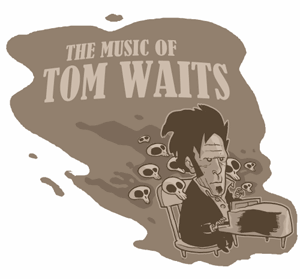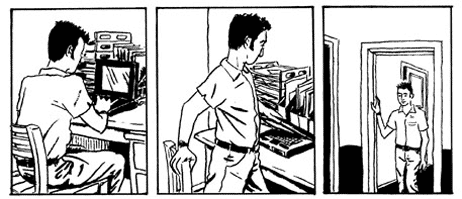Previous to my life as a comics blogger, I originally started blogging about the idea of "constraint" in literature. Constraint? you say. Like some kind of bondage? Alas, no.
I, drawing on a number of authors, define constraint as a non-conventional rule applied systematically and voluntarily to the creation of a work.
Non-conventional in the sense that rules of grammar are excluded as are limiting factors such as the conventional paper size of a comic pamphlet. Using a consistent six-panel grid for a comic is conventional and not a constraint as such.
Systematic meaning applied across the entirety of a work (or a contained part of a work (a chapter for instance). The rule is not applied selectively or at whim. Some form of system is involved.
Voluntarily to say that issues such as censorship do not constitute a constraint, though they may constrain what an artist may do and often produce similar results.
When I say rule, this could mean numerous forms of principles, restrictions, or structures applied to the creative process. Prominent examples, include Georges Perec's famous novel written without the use of the letter "e", Matt Madden's use of the same basic story told 99 times in his Exercise in Style, Doug Nufer's "Never Again" a novel in which no word is repeated, or a few of the examples I'll mention below.
To what purpose?
Conventional wisdom has it that the artist has complete freedom. Struck by some inspiration the artist creates. But if one thinks about artistic creation any number of choices are made which conflict with this idea of freedom. Simply by choosing a medium or form (comic, film, writing) limits are set on possibilities. Conventions of genre are limiting in some ways (though almost never in a systematic manner), as are limits on skill, tools, or knowledge.
The idea of a constraint, in this context, is to set restrictions for creation as a spur to art as problem-solving exercise. By taking charge of the constraint the creator is forced to think in new ways, to explore paths they might not otherwise have taken, to stretch their mind and creative abilities. The use of constraint is an excellent way to break out of a rut, to vary one's output, to discover new avenues.
I use constraint rather frequently in my webcomic, Things Change, to force myself to experiment with different aspects of comics (such as color, panel layouts, text, etc). In a current sequence, I'm doubling the number of panels on the page from one to the next, starting with a single panel page and moving to a page with 32 (or maybe 64) panels. This creates a sense of increasing pace and fragmentation which ended up directing the path of the story (which I had a final point for, but wasn't sure how to get there).
Voluntary constraints are becoming more and more prominent in comics lately. I've seen a number of things going on, which spurred on my writing this column. Here's a few that are very recent and others that have been around for years:
Probably the best known example in comics circles. The rules are simple: produce a 24 page comic in 24 hours. This is a formal and procedural constraint which leaves the content completely open. As such it serves to encourage spontaneity. With the associated sense of informality this brings, artists are more likely to work outside their normal comfort zone. (Similarly, for prose writers is National Novel Writing Month, which happens to be this month.)
I only recently discovered this site, which offers a different challenge (constraint) on a weekly basis (52 challenges for 52 weeks). As their about page says: "52 Comic Challenges is a weekly exercise designed to shake you out of old habits and encourage you to try new things and push your limits in comic making." I haven't tried any of these yet, but there are a few familiar (24 hour comics, draw a wordless comic) constraints and a few new ones (draw a comic using all five words from a Pictionary card). The latter is an interesting example of a constraint on the semantic content of a comic. This type of thing can easily lead to artists taking on subjects, places, or people that they would never have thought to deal with previously. The site has some great ideas but I think the weekly challenge seems a little too much too often (particularly if you are someone already doing weekly pages for your webcomic). They're only up to challenge #12, so there's plenty of time to join in.
 C) OuBaPo
C) OuBaPo
Constraints in Comics are most famously the province of the OuBaPo (Ouvroir de Bande Dessinee Potentielle, that's Laboratory/Workshop for Potential Comics in French), an off-shoot of the OuLiPo, a group formed to experiment with constraint in literature (and pretty much the modern origin of the idea). The OuBaPo have a few volumes of their "Oupus" out through France's L'Assocation. Lewis Trondheim is the member most known in the US, though I don't believe much if any of his constrained work has appeared in translation. For reviews of some of their publications see this list.
D) OuCoPo
This is a recent appearance (the site appeared in September) whose name is modeled on the French group. Started by Jon Morris, it's basically a site to set out monthly constraints and publish the results as submitted by whoever wants to participate. This month's theme is Tom Waits.
E) Tom Hart's Hutch Owen
Taking a cue from the Lars Von Trier film "The Five Obstructions", Matt Madden created 5 sets of constraints for Tom Hart to follow in creating a week of his Hutch Owen strip. Unfortunately many of the final strips were a little too outlandish for Hart's publisher. Some of the constraints: use 20 panels in one strip, writing one strip from last panel to first panel, a strip that could only include text, panel borders, balloons, solid black, and emanata, and a strip based on the tracing of a Roy Crane strip.
Isaac Cates and Mike Wenthe have been creating constrained mini-comics for years under the title Satisfactory Comics (2001-present), and now they've got a website. Most recently they been blogging the creation of a story for the indie "Elfworld" anthology. The got a number of comic artists (Tom Hart, Jesse Reklaw) to provide constraints for them in 2 page groups (borrowing from Hart's process mentioned above). It's a fascinating process to follow along with (still ongoing), which you can through this category on their blog.
G) Matt Madden
Madden is probably the most well known proponent of constraint in comics. His "99 Ways to Tell a Story: Exercises in Style" is a tour-de-force of comics creation that every comic artist should read. In it, Madden retells the same banal story in 99 different ways from genres, styles, forms, perspectives, and all kinds of other things. His pamphlet comic "A Fine Mess" (2 issues) features a number of constrained comics including a comics sestina. He occasionally posts comics to his blog, like this one.

A mostly non-existant group based on the OuBaPo that exists in the form of a listserv and a website. Originally formed by Madden, Hart, and Jason Little, there isn't much activity, but their website has a translation of OuBaPo member (and comics theorist) Thierry Groensteen's list of constraints, which is as fine a place as any to get some ideas.
I can't neglect Ryan North's long running webcomic which features the same art everyday with altered text. The unceasing fun of this comic is some form of testament to the power of the constraint.
If you'd like to learn more, you can check out the Constraint category on my blog, which has about 90 posts going back a few years.
Comments are closed.